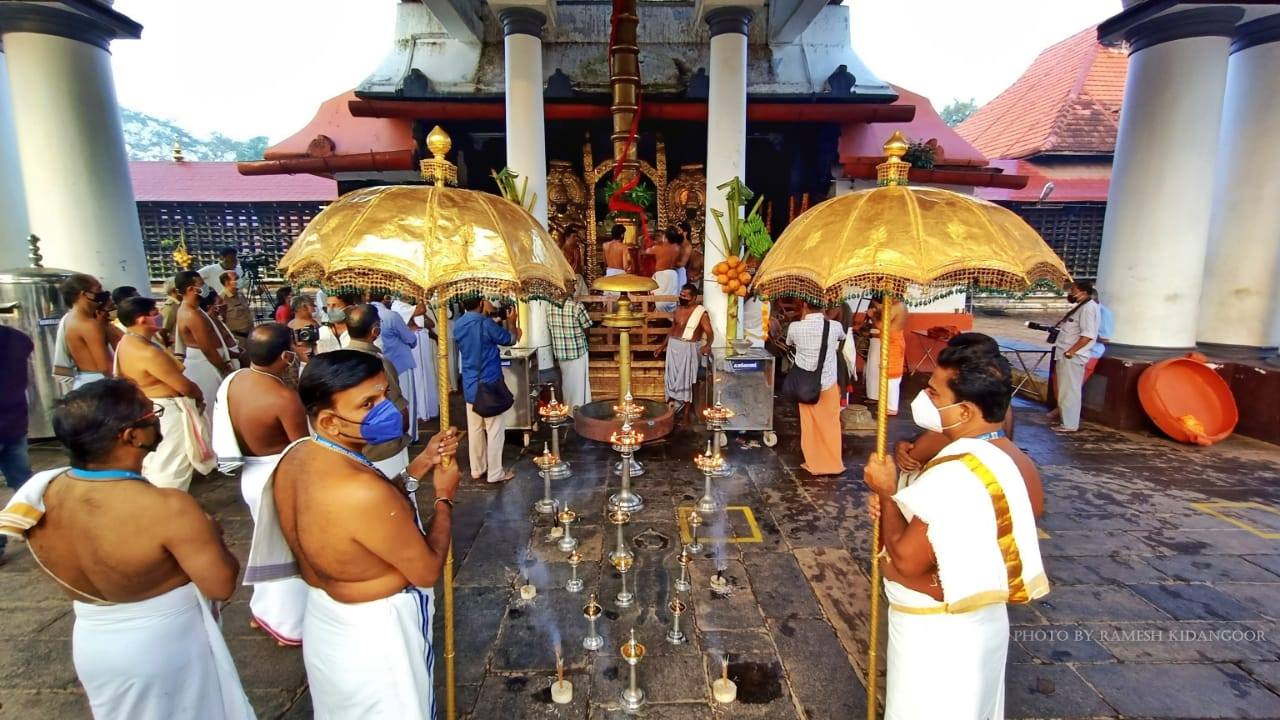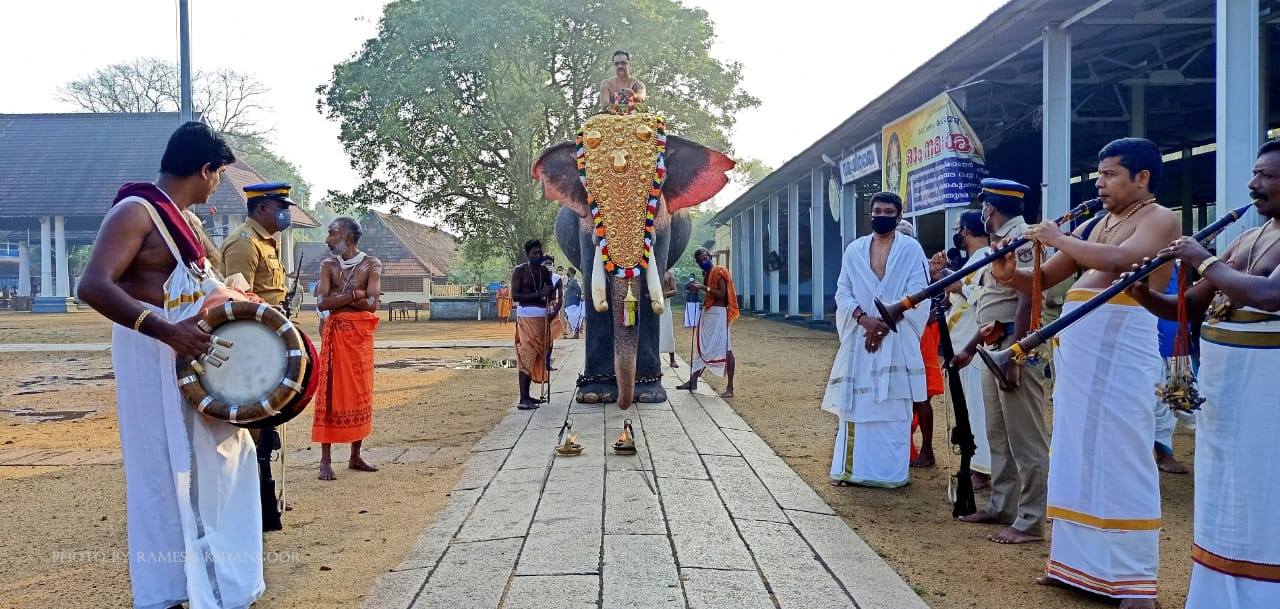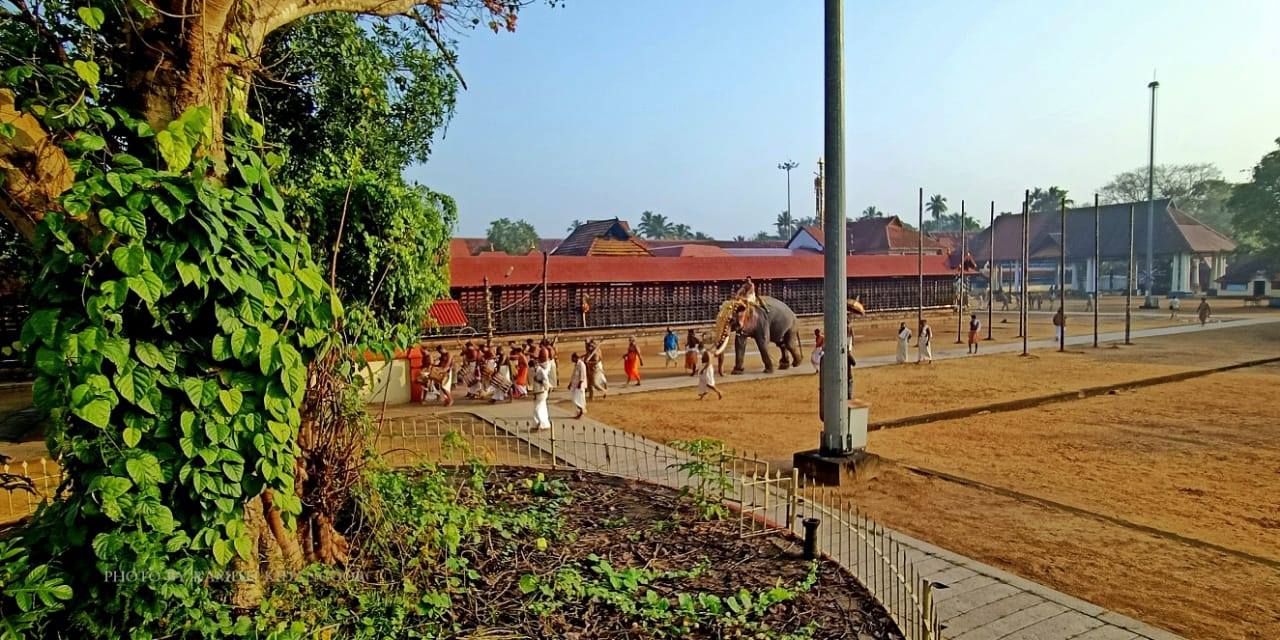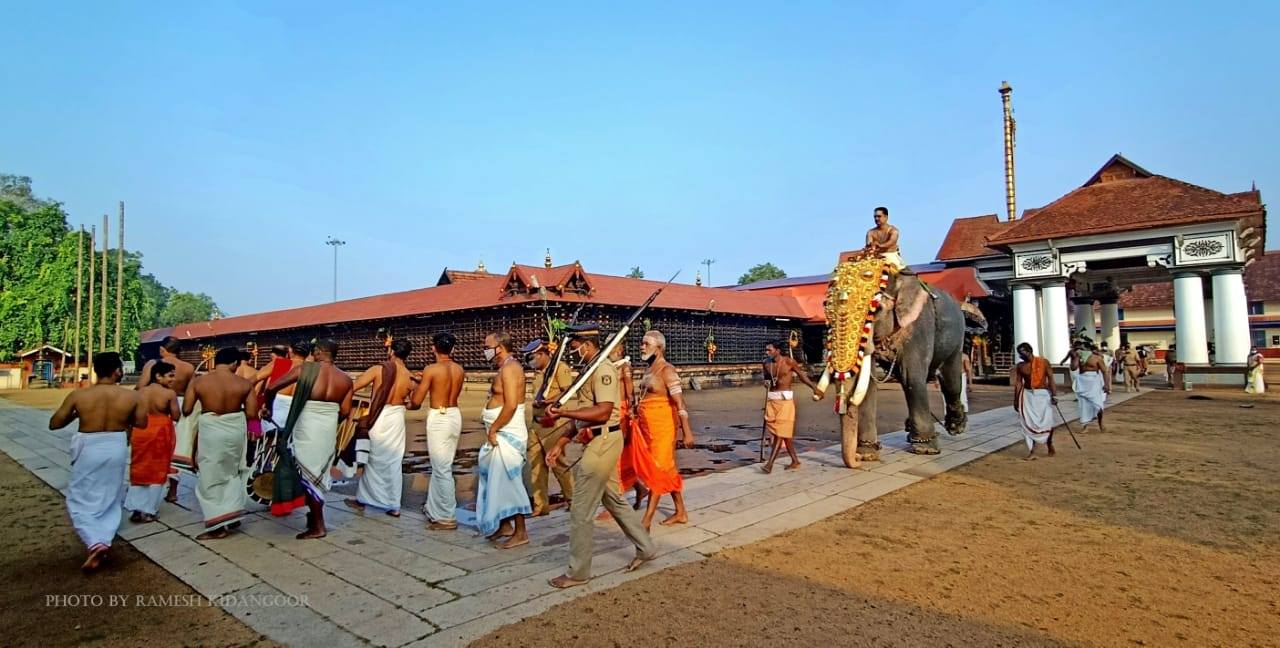Vaikom Sree Mahadeva Temple is a revered Hindu temple dedicated to Lord Shiva, located in Vaikom, Kottayam, Kerala. It is one of the oldest and most significant Shiva temples in South India.

Vaikom Sree Mahadeva Temple is revered by both Shaivas, the followers of Shiva, and Vaishnavas, the followers of Vishnu. Lord Shiva is affectionately known as Vaikkathappan, the lord of Vaikom. The lingam enshrined in the temple is believed to be from the Treta Yuga, making it one of the oldest temples in Kerala with an unbroken tradition of worship.
According to legend, the demon Khara, after receiving the sacred knowledge of Shaivism from Malyavan, performed severe penance in Chidambaram, Tamil Nadu, seeking liberation (moksha). Pleased with his devotion, Lord Shiva appeared before him and granted three powerful lingams, assuring his eternal presence in them.
As Khara journeyed south from the Himalayas carrying the three lingams—one in each hand and the third around his neck—he paused to rest at Vaikom. When he attempted to lift the lingams again, they remained immovable. Realizing it was Shiva’s divine will, he heard a celestial voice proclaim that Shiva would reside there, offering salvation to all who seek refuge in him. Khara, having attained liberation, entrusted the lingams to the sage Vyaghrapada, who had been following him unseen, instructing him to protect and worship them.
On the auspicious day of Vrichika Ashtami, Lord Shiva and Goddess Parvati appeared before the sage Vyaghrapada and proclaimed that the place would be known as Vyaghrapadapurma before disappearing. This event is commemorated even today through the world-famous Vaikkathashtami festival, which is celebrated annually on Vrichika Ashtami.
Nearby, the Sri Kochalumchuvadu Bhagavathy Amman Temple, dedicated to a form of Goddess Kali, stands as the consort of Vaikkathappan.
After years of devoted worship, Vyaghrapada left on a pilgrimage. Many years later, Parashurama, the sixth incarnation of Vishnu, passed by the area and witnessed divine omens. Upon discovering the submerged lingam emitting heavenly radiance, he recognized it as the sacred lingam placed by Khara. Realizing its significance, Parashurama consecrated the lingam with intense devotion, reciting holy mantras.
Pleased with his devotion, Lord Shiva appeared before Parashurama along with Goddess Parvati.
Seeing the proper rituals being followed, Shiva blessed the site and granted divine grace. Overwhelmed with joy, Parashurama performed pujas at the location for several days. Later, he constructed a temple and entrusted a noble Brahmin from the Taruna village to oversee its rituals. Teaching him the sacred chants, mantras, and puja procedures, Parashurama appointed him as the chief priest and donated the temple before disappearing. It is believed that the temple's customs and rituals were established by Parashurama himself.
At Vaikom Sree Mahadeva Temple, Lord Shiva is worshipped in three distinct incarnations throughout the day: in the morning as Dakshinamurthi, in the afternoon as Kiratamurthi, and in the evening as Shakti Panchakshari, bestowing blessings upon devotees in each form.
In ancient times, the Vaikom Sree Mahadeva Temple was under the ownership of 108 Brahmin families. Over time, conflicts arose among them, and they divided into two factions, with one group aligning with the ruling king. Their disputes escalated, creating unrest within the temple administration.
One fateful noon, a faction of the divided group entered the temple with the intent of disrupting the rituals. Njallal Namboothiri, the leader of one group, forcefully barged into the temple and interrupted the puja. At that moment, the naivedyam (food offering) for the deity was placed on the western side of the Namaskara Mandapa hall. In an act of great disrespect, Njallal Namboothiri entered through the western door, draped his shawl above it, and spat the remnants of his paan on the sacred offering, thereby defiling the puja.
As he turned to leave, he reached for his shawl but was bitten by a highly venomous snake. Stricken with unbearable pain, he crawled toward the western door, where he succumbed to the poison and died. At that very moment, the temple’s western door shut by itself. A divine voice emerged from the sanctum sanctorum, declaring, "This door should never be opened again!" Since then, the western door of the temple has remained permanently closed, serving as a reminder of Lord Shiva’s wrath against those who desecrate his worship.
Vaikom Sree Mahadeva Temple is one of the largest temples in Kerala, with a sprawling courtyard covering approximately eight acres. The temple premises are leveled with river sand and enclosed by high compound walls, featuring four grand gopurams (entrance towers) on all four sides. Unlike most temples in Kerala, which are built in a precise East-West alignment, such as Ettumanoor and Kaduthuruthy temples, the Vaikom temple has a slight five-degree tilt in the North-South direction.
The sanctum sanctorum of the temple is unique in its architecture. While it appears circular from the outside, it is actually oval in shape, an architectural rarity in Kerala temple design. The oval structure becomes evident when measuring the width of the antharala, the inner sanctum passage. This design is attributed to Perumthachan, the legendary master architect of Kerala, who is also believed to have built the original sanctum of the Chengannur temple, which had a similar elliptical base.
Mukha Mandapa, the first pillared hall leading to the sanctum, is constructed using intricately shaped stone and massive single-piece wooden beams. The structure is notable for its strength, with stone-built walls and sturdy pillars. The garbhagriha, the innermost sanctum where the lingam resides, is entirely made of stone, including the roof, and is square in shape.
A remarkable feature of the temple is that devotees cannot directly see the deity from the entrance without ascending a six-step staircase. These six steps symbolize the six vikaras, or impurities, of human nature: kama, krodha, lobha, moha, mada, and matsarya. Ascending these steps represents a spiritual journey of self-purification, leading to liberation, or moksha.
Vaikom temple is famous for the Vaikom Ashtami (Vaikathashtami), one of its main festivals, which is held between November and December. The exact date of the festival is determined by the Malayalam calendar. Vaikathashtami is celebrated on the day of Krishna Ashtami in the Malayalam month of Vrischikam. It commemorates the appearance of Shiva before Vyaghrapada.
വൈക്കം ശ്രീ മഹാദേവ ക്ഷേത്രം
വൈക്കം മഹാദേവ ക്ഷേത്രം കോട്ടയം ജില്ലയിലെ വൈക്കം നഗരഹൃദയത്തിൽ സ്ഥിതിചെയ്യുന്ന പ്രശസ്തമായ ഒരു ക്ഷേത്രമാണ്. പരശുരാമൻ സ്ഥാപിച്ച കേരളത്തിലെ 108 ശിവക്ഷേത്രങ്ങളിൽ ഒന്നാണെന്നു കരുതപ്പെടുന്നു. പത്തേക്കറിലധികം വിസ്തീർണമുള്ള ഈ ക്ഷേത്രം കിഴക്കോട്ട് ദർശനമായിട്ടാണ് നിർമ്മിച്ചിരിക്കുന്നത്. ശ്രീ പരമേശ്വരനും ശ്രീ പാർവതിയും ഇവിടേയ്ക്ക് പ്രതിഷ്ഠിച്ചിരിക്കുന്നു.
ഇവിടുത്തെ മഹാദേവനെ "അന്നദാനപ്രഭു" എന്ന പേരിലും അറിയപ്പെടുന്നു. ക്ഷേത്രാങ്കണത്തിന്റെ വടക്കേയറ്റത്ത് രണ്ടുനില ഊട്ടുപുരയുണ്ടായി, അതിൽ ക്ഷേത്രകലാപീഠവും പ്രവർത്തിക്കുന്നു. ഊട്ടുപുരയുടെ വടക്കുഭാഗത്ത് അമ്പലക്കുളവും സ്ഥിതിചെയ്യുന്നു. ക്ഷേത്രത്തിന്റെ പടിഞ്ഞാറുഭാഗത്ത് വേമ്പനാട്ട് കായൽ നീണ്ടുനിവർന്നുകിടക്കുന്നു, അവിടെ ബോട്ട് ജെട്ടിയുമുണ്ട്, വെളളപ്പാതയിലൂടെ ദിവസവും ബോട്ട് സർവ്വീസ് ലഭ്യമാണ്.
ക്ഷേത്രത്തിലെ ഉപദേവതകളായി ഗണപതി (മൂന്നു പ്രതിഷ്ഠകൾ – രണ്ടെണ്ണം നാലമ്പലത്തിനകത്തും ഒന്ന് പുറത്തും), സുബ്രഹ്മണ്യൻ, നാഗദൈവങ്ങൾ, പനച്ചിയ്ക്കൽ ഭഗവതി എന്നിവയെ ആരാധിക്കുന്നു.
ക്ഷേത്രത്തിലെ പ്രധാന ഉത്സവങ്ങൾ വൃശ്ചികമാസത്തിൽ കറുത്തപക്ഷത്തിലെ നവമി ആറാട്ടോടൊപ്പം ആഘോഷിക്കപ്പെടുന്ന വൈക്കത്തഷ്ടമി ഉത്സവം, ധനുമാസത്തിലെ തിരുവാതിര, കുംഭമാസത്തിലെ ശിവരാത്രി, കുംഭാഷ്ടമിച്ചിറപ്പ്, മണ്ഡലകാലം, വിഷു എന്നിവയാണ്.
വൈക്കം മഹാദേവ ക്ഷേത്രം തിരുവിതാംകൂർ ദേവസ്വം ബോർഡിന്റെ കീഴിലാണ് പ്രവർത്തിക്കുന്നത്. ഒരു പ്രവചനപ്രകാരം ഭഗവാൻ ശിവന്റെ അറ്റമില്ലാത്ത സ്വരൂപം കണ്ടെത്താനായി ബ്രഹ്മാവും മഹാവിഷ്ണുവും ശ്രമിച്ചു. എന്നാൽ, ശിവലിംഗത്തിന്റെ അറ്റം കണ്ടതായി അസത്യം പറഞ്ഞതിനായി ഭഗവാൻ ശിവൻ ബ്രഹ്മാവിന്റെ അഞ്ച് തലകളിലൊന്ന് വെട്ടിമാറ്റി. ഇതിന്റെ ഫലമായി ഭഗവാനെ ബ്രഹ്മഹത്യാ പാപം ബാധിച്ചു. ഇതിന് പരിഹാരം കാണാനായി ഭഗവാൻ ശിവൻ ബ്രഹ്മാവിന്റെ തലയോട്ടി കയ്യിൽ എടുത്ത് പാർവ്വതീദേവിയോടൊപ്പം നാടുവഴിയിലൂടെ ഭിക്ഷ യാചിച്ചു.
വിശ്വാസപ്രകാരം, ഭഗവാൻ ശിവന് ഭിക്ഷയായി പലരും ദാനങ്ങൾ നൽകി. എന്നാൽ, തലയോട്ടി നിറഞ്ഞാൽ അതിക്ഷണമായി അത് അദ്ദേഹം ഭസ്മമാക്കിക്കളഞ്ഞു. അങ്ങനെ, പന്ത്രണ്ടുവർഷം നീണ്ടുനിന്ന ഈ യാത്രയിൽ ഭഗവാൻ ദേവിയോടൊപ്പം ഇന്നത്തെ വൈക്കം മഹാദേവ ക്ഷേത്രം സ്ഥിതിചെയ്യുന്ന സ്ഥലത്തെത്തി. അപ്പോഴും തലയോട്ടി നിറഞ്ഞിരിയ്ക്കുന്നുണ്ടായിരുന്നു. എന്നാൽ, പതിവിന് വിപരീതമായി ഭഗവാൻ ശിവൻ, തലയോട്ടി വയ്ക്കാമെന്ന് നിർദേശിച്ചു.
ഇതിന്റെ അടിസ്ഥാനത്തിലാണ് ‘വയ്ക്കാം’ എന്ന പ്രയോഗം ഉണ്ടായതെന്ന് വിശ്വസിക്കപ്പെടുന്നു. ഇത് അദ്ധ്യാത്മിക ദർശനത്തിലും ക്ഷേത്രം ലഭിച്ച മഹാത്മ്യത്തിലും വലിയ പ്രാധാന്യമുള്ള കഥയാണ്.
ഖരൻ എന്ന അസുരൻ തന്റെ മുത്തച്ഛനായ മാല്യവാനിൽ നിന്ന് ശൈവവിദ്യ ഗ്രഹിച്ച്, ചിദംബരത്തുപോയി ഭഗവാൻ ശിവനെ പ്രീതിപ്പെടുത്താനായി തപസ്സാരംഭിച്ചു. ഭക്തന്റെ തപസ്സിൽ സംപ്രീതനായ ഭഗവാൻ ശിവൻ അവന് മൂന്ന് ശിവലിംഗങ്ങൾ സമ്മാനിച്ചു.
ശിവലിംഗങ്ങൾ കൈവശം വെച്ചുകൊണ്ട് ആകാശമാർഗ്ഗേണ യാത്ര ആരംഭിച്ച ഖരൻ, അവയുടെ ഭാരം കാരണം അല്പനേരം വിശ്രമിക്കാനായി വൈക്കത്തെത്തി. വിശ്രമിക്കുമ്പോൾ, തന്റെ വലതുകയ്യിലെ ശിവലിംഗം അവിടെയിറക്കി. ഉണർന്നെഴുന്നേറ്റ് അതിനെ തിരികെ എടുക്കാൻ ശ്രമിച്ചപ്പോൾ, ലിംഗം ഭൂമിയിൽ സ്ഥിരമായി ആസ്ഥാനമാക്കിയതായി മനസ്സിലാക്കി.
ആ സമയത്ത്, ഭഗവാൻ ശിവഭഗവാന്റെ അശരീരി മുഴങ്ങി: "ഇതാണ് നീ താമസിക്കാൻ ഏറ്റവും ആഗ്രഹിക്കുന്ന സ്ഥലം." തുടർന്ന്, ശിവലിംഗം അവിടെയായിരിക്കാൻ സമ്മതിച്ച ഖരൻ, അതിനെ തപസ്സിരുന്ന വ്യാഘ്രപാദ മഹർഷിക്കു ഏൽപ്പിച്ച് മുക്തിയടഞ്ഞു.
പിന്നീട്, ഖരൻ തന്റെ ഇടത് കയ്യിലുള്ള ശിവലിംഗം എറ്റുമാനൂർ മഹാദേവക്ഷേത്രത്തിൽ, വായിൽ കടിച്ചുപിടിച്ച ശിവലിംഗം കടുത്തുരുത്തി തളി മഹാദേവക്ഷേത്രത്തിൽ പ്രതിഷ്ഠിച്ചു. ഇന്നും, ഈ മൂന്ന് ക്ഷേത്രങ്ങളിലും ഉച്ചപ്പൂജയ്ക്ക് മുമ്പ് ദർശനം നടത്തുന്നത് വലിയ പുണ്യകരമായി വിശ്വസിക്കപ്പെടുന്നു.
കിഴക്കേ ഗോപുരത്തിലൂടെ പ്രവേശിക്കുമ്പോൾ ആദ്യം കാണുന്നത് ആനക്കൊട്ടിലും, അതിന്റെ വടക്കുഭാഗത്ത് ത്രിമൂർത്തിസാന്നിധ്യമുള്ള പുണ്യവൃക്ഷമായ അരയാലുമാണ്,ക്ഷേത്രത്തിൽ കേരളത്തിലെ ഏറ്റവും ഉയരമേറിയ സ്വർണ്ണക്കൊടിമരവും, ഭീമാകാരമായ കരിങ്കൽത്തൂണുകളും, ഭഗവദ്വാഹനമായ നന്തിയും ദർശിക്കാം. ബലിക്കൽപ്പുരയിൽ ഭീമാകാരമായ ബലിക്കല്ലും ബ്രഹ്മാവിന്റെയും അഷ്ടദിക്പാലകരുടെയും പ്രതിമകളും കാണാം. ശിവദർശനത്തിന് മുമ്പ് ഭക്തർ ആദ്യമായി തൊഴുന്നതും പ്രശസ്തമായ 'സ്തംഭഗണപതി' പ്രതിഷ്ഠയ്ക്കാണ്, ഈ പ്രതിഷ്ഠയ്ക്ക് അതീവ പ്രാധാന്യമുണ്ട്.
ശ്രീകോവിൽ അതിമനോഹരമായ ചുവർച്ചിത്രങ്ങളാൽ അലംകൃതമാണ് നടരാജൻ, ദശാവതാരം, ശ്രീദേവീഭൂദേവീസമേതനായ മഹാവിഷ്ണു, അർജുനനെ പരീക്ഷിച്ച് പാശുപതാസ്ത്രം നൽകുന്ന ശിവൻ - അങ്ങനെ വിവിധതരം ചുവർച്ചിത്രങ്ങൾ .ശ്രീകോവിലിന്റെ പടിഞ്ഞാറേ നടയിൽ അടഞ്ഞ ഒരു വാതിൽ കാണാം. അവിടെ പാർവ്വതീസാന്നിദ്ധ്യമുള്ളതായി വിശ്വസിയ്ക്കപ്പെടുന്നു. ആ നട തുറക്കാറില്ല. പകരം വിളക്കുവയ്പ് മാത്രമേയുള്ളൂ. വടക്കുവശത്ത് ഓവ്, വ്യാളീമുഖത്തോടെ മനോഹരമായി നിർമ്മിച്ചിരിയ്ക്കുന്നു. ഭഗവാന് അഭിഷേകം ചെയ്യുന്ന ദ്രവ്യങ്ങൾ ഇതിലൂടെ ഒഴുകിപ്പോകുന്നു. ശിവക്ഷേത്രമായതിനാൽ ഇതിനപ്പുറം പ്രദക്ഷിണം നിരോധിച്ചിരിയ്ക്കുന്നു.
ക്ഷേത്രത്തിലെ പ്രധാന ഉത്സവം വൃശ്ചികമാസത്തിലെ വൈക്കത്തഷ്ടമി മഹോത്സവമാണിത്, കൊടിയേറ്റവും ആറാട്ടും നോക്കിയല്ല ഉത്സവം നടത്തപ്പെടുന്നത് എന്നതിൽ അതിന് പ്രത്യേക പ്രാധാന്യമുണ്ട്. മൊത്തം പതിമൂന്ന് ദിവസം നീളുന്ന ഉത്സവത്തിൽ അഷ്ടമി പന്ത്രണ്ടാം നാളായി വരുന്ന വിധത്തിൽ ഉത്സവക്രമം ക്രമീകരിച്ചിരിക്കുന്നു, ഈ ദിവസം ധാരാളം ഭക്തർ ക്ഷേത്രത്തിൽ എത്തുന്നു. അങ്കുരാദിയായി ആരംഭിക്കുന്ന ഉത്സവം മുളയിടലും കലശാഭിഷേകവും വഴി തുടക്കം കുറിക്കുമ്പോൾ, സന്ധ്യയ്ക്ക് കൊടിയേറ്റം നടക്കുന്നു. പതിമൂന്ന് ദിവസം നീളുന്ന ഗംഭീര ആഘോഷങ്ങളാൽ സമ്പന്നമായ ഈ ഉത്സവത്തിൽ രോഹിണിദിവസം സന്ധ്യയ്ക്ക് അതിവിശേഷമായ കൂടിപ്പൂജ നടക്കുന്നു.
വൈക്കത്തപ്പന്റെ പുത്രനായ ഉദയനാപുരത്തപ്പൻ (സുബ്രഹ്മണ്യൻ) ക്ഷേത്രത്തിൽ നിന്ന് ഒരു കിലോമീറ്റർ അകലെയുള്ള കുളത്തിൽ ആറാട്ട് കഴിഞ്ഞ് തിരിച്ച് പോകുമ്പോൾ, പിതാവിനെ കാണാൻ വൈക്കത്തെത്തുകയും ഇരുവരുടെയും ബിംബങ്ങൾ അടുത്തുവച്ച് ശ്രീകോവിൽ നടയടച്ച് പൂജ ആരംഭിക്കുകയും ചെയ്യുന്നു. ഈ ഘട്ടത്തിൽ ശിവൻ പാർവ്വതീഗണപതീസുബ്രഹ്മണ്യസമേതനായി കൈലാസത്തിൽ അമരുന്നു എന്നാണ് വിശ്വാസം. കൂടിപ്പൂജയുടെ മന്ത്രങ്ങൾ തന്ത്രിയ്ക്കും മേൽശാന്തിയ്ക്കും മാത്രമേ അറിയൂ, അതിന്റെ രഹസ്യമായ താത്പര്യവും അതീവ വിശേഷവുമാണ്.
ഉത്സവത്തിന്റെ പന്ത്രണ്ടാം ദിവസമാണ് പ്രസിദ്ധമായ വൈക്കത്തഷ്ടമി, അന്ന് പതിവിനേക്കാൾ ഒരുമണിക്കൂർ നേരത്തേ നട തുറന്നു മഹാനിർമ്മാല്യ ദർശനം നടത്തുന്നതിനായി ഭക്തജനങ്ങൾ വലിയ തിരക്കേറും. പുലർച്ചെ 4.30 മുതൽ ദർശനം ആരംഭിച്ച് അഷ്ടമിദിവസം മഹാദേവനെ ദർശിച്ചാൽ ദുഃഖങ്ങൾ അകന്ന് അഭീഷ്ടസിദ്ധിയും വിജയവും ലഭിക്കും എന്നതാണ് വിശ്വാസം. സുബ്രഹ്മണ്യപ്രീതിയും അഷ്ടമി ദർശനത്തിലൂടെ ലഭിയ്ക്കുമെന്നാണ് സങ്കല്പം. അന്ന് ക്ഷേത്രത്തിൽ നിവേദ്യങ്ങളില്ല, കാരണം പുത്രനായ സുബ്രഹ്മണ്യന്റെ വിജയത്തിനായി ഭഗവാൻ ശിവൻ ഉപവാസമനുഷ്ഠിയ്ക്കുന്നുവെന്നാണ് വിശ്വാസം.
എന്നാല് ഭക്തർക്കു ഗംഭീര സദ്യ ഒരുക്കിയിരിക്കും, കാരണം ഭഗവാൻ ശിവൻ താനൊഴികെ മറ്റാരും അന്ന് പട്ടിണി കിടക്കരുതെന്ന് നിർബന്ധം വെച്ചിരിയ്ക്കുമെന്നാണ് വിശ്വാസം. അഷ്ടമിദിവസം മാത്രം ക്ഷേത്രത്തിലെ വടക്കേ ഗോപുരം തുറക്കുകയും അതിലൂടെ ഉദയനാപുരത്തപ്പന്റെ എഴുന്നള്ളത്ത് നടക്കുകയും ചെയ്യും. താരകാസുരനെയും സിംഹമുഖനെയും ശൂരപത്മനെയും വധിച്ചശേഷം വാദ്യഘോഷങ്ങളുടെ അകമ്പടിയോടുകൂടി സുബ്രഹ്മണ്യൻ ക്ഷേത്രത്തിലേക്ക് വരുമ്പോൾ, മഹാദേവൻ കിഴക്കേ ആനക്കൊട്ടിലിലേയ്ക്ക് അദ്ദേഹത്തെ കൊണ്ടുപോകും.
തുടർന്ന് ഭക്തജനങ്ങൾ കറുകയിൽ കൈമളയോടുകൂടി ആദ്യമായി കാണിക്കയിടുകയും ദേവസ്വം അധികൃതർ ഉൾപ്പെടെയുള്ളവർ മഹാദേവനെ കാണിക്കയിടുകയും ചെയ്യും. വൈക്കത്തിനടുത്ത് താമസിയ്ക്കുന്ന ഭക്തർ അഷ്ടമിദിവസം ക്ഷേത്രത്തിൽ വന്ന് തൊഴുതില്ലെങ്കിൽ, അത് അപകടകരമാകുമെന്നാണ് വിശ്വാസം. ഉത്സവത്തിന്റെ പന്ത്രണ്ടാം ദിവസമാണ് പ്രസിദ്ധമായ വൈക്കത്തഷ്ടമി, അന്ന് പതിവിനേക്കാൾ ഒരുമണിക്കൂർ നേരത്തേ നട തുറന്നു മഹാനിർമ്മാല്യ ദർശനം നടത്തുന്നതിനായി ഭക്തജനങ്ങൾ വലിയ തിരക്കേറും. പുലർച്ചെ 4.30 മുതൽ ദർശനം ആരംഭിച്ച് അഷ്ടമിദിവസം മഹാദേവനെ ദർശിച്ചാൽ ദുഃഖങ്ങൾ അകന്ന് അഭീഷ്ടസിദ്ധിയും വിജയവും ലഭിക്കും എന്നതാണ് വിശ്വാസം.
സുബ്രഹ്മണ്യപ്രീതിയും അഷ്ടമി ദർശനത്തിലൂടെ ലഭിയ്ക്കുമെന്നാണ് സങ്കല്പം. അന്ന് ക്ഷേത്രത്തിൽ നിവേദ്യങ്ങളില്ല, കാരണം പുത്രനായ സുബ്രഹ്മണ്യന്റെ വിജയത്തിനായി ഭഗവാൻ ശിവൻ ഉപവാസമനുഷ്ഠിയ്ക്കുന്നുവെന്നാണ് വിശ്വാസം. എന്നാല് ഭക്തർക്കു ഗംഭീര സദ്യ ഒരുക്കിയിരിക്കും, കാരണം ഭഗവാൻ ശിവൻ താനൊഴികെ മറ്റാരും അന്ന് പട്ടിണി കിടക്കരുതെന്ന് നിർബന്ധം വെച്ചിരിയ്ക്കുമെന്നാണ് വിശ്വാസം. അഷ്ടമിദിവസം മാത്രം ക്ഷേത്രത്തിലെ വടക്കേ ഗോപുരം തുറക്കുകയും അതിലൂടെ ഉദയനാപുരത്തപ്പന്റെ എഴുന്നള്ളത്ത് നടക്കുകയും ചെയ്യും.
താരകാസുരനെയും സിംഹമുഖനെയും ശൂരപത്മനെയും വധിച്ചശേഷം വാദ്യഘോഷങ്ങളുടെ അകമ്പടിയോടുകൂടി സുബ്രഹ്മണ്യൻ ക്ഷേത്രത്തിലേക്ക് വരുമ്പോൾ, മഹാദേവൻ കിഴക്കേ ആനക്കൊട്ടിലിലേയ്ക്ക് അദ്ദേഹത്തെ കൊണ്ടുപോകും. തുടർന്ന് ഭക്തജനങ്ങൾ കറുകയിൽ കൈമളയോടുകൂടി ആദ്യമായി കാണിക്കയിടുകയും ദേവസ്വം അധികൃതർ ഉൾപ്പെടെയുള്ളവർ മഹാദേവനെ കാണിക്കയിടുകയും ചെയ്യും.
വൈക്കത്തിനടുത്ത് താമസിയ്ക്കുന്ന ഭക്തർ അഷ്ടമിദിവസം ക്ഷേത്രത്തിൽ വന്ന് തൊഴുതില്ലെങ്കിൽ, അത് അപകടകരമാകുമെന്നാണ് വിശ്വാസം. ഉദയാസ്തമയ പൂജ, പ്രദോഷ പൂജ, ഉമാമഹേശ്വര പൂജ, സ്വയംവര പുഷ്പാഞ്ജലി, മൃത്യുഞ്ജയ ഹോമം, മൃത്യുഞ്ജയ അർച്ചന, ആയുർസൂക്ത പുഷ്പാഞ്ജലി, രുദ്രസൂക്ത പുഷ്പാഞ്ജലി, കൂവളഹാര സമർപ്പണം തുടങ്ങിയവ ക്ഷേത്രത്തിൽ നടക്കുന്ന പ്രധാന വഴിപാടുകളാണ്.
Address:
Vaikom, Kerala 686141



